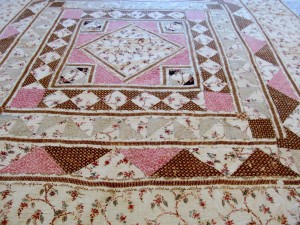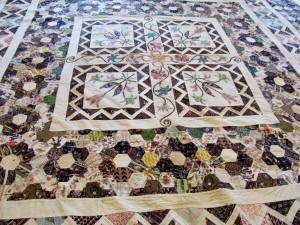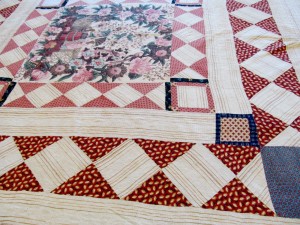A Brief History of Cumbrian Quilting
We have a huge collection of objects here at Tullie House that are unfortunately not on permanent display in the museum, one that we get asked about a lot is our beautiful quilt collection. Eloise, one of our Curatorial Assistants and Exhibitions Engagement Coordinator worked with Melanie, our Curator of Fine Art on a recent afternoon study session when we got the quilts out for some of our visitors to see. Eloise has written up a brief history of Cumbrian Quilting to share this collection with you.
Quilts offer a fascinating window into the private lives and creativity of the women who made them. Stitch-work is the image of female domesticity and industry; represents virtues of thrift, practical skill, patience and artistic flair. It also shows a scope of pattern and colour design, geometry and technical prowess.
Cord Quilting is an early pattern technique, popular in the 17th and 18th centuries. Typically made of white linen or cotton, into which raised designs were stitched using cotton or woolen cord.
The Tullie House collection starts in the 18th Century. Held up to the light, this cord-quilted coverlet c.1700-1800 reveals intricate and beautiful patterns of flowers and eternity knots, including daffodils, honeysuckle, primroses and other wildflowers, gorgeously rendered into a diamond pattern.
Probably the most significant quilt from the Tullie House collection is this beautiful patchwork bedspread made by Martha Jackson of Westmorland in 1790. Rare in that we know who made it- Martha actually signed and dated her work! It is also an extensive catalogue of samples of 18th Century printed dress cottons and calicos, which presumably reflect the clothes worn by Martha and the Jackson family. It is easy to imagine Jane Austen’s characters Mrs Bennet or Mrs Dashwood wearing dresses in these patterns in their youth!
It is fascinating to see how modern some of the fabric patterns and colours seem compared to designs popular on clothes of the 1960’s, 70’s and 80’s.
This rare patchwork of Georgian fabric even includes import stamps, pieced into the quilt, revealing the early beginnings of printed cottons imported from India by dress-makers around the country. For a long time, such fabrics were illegal, since they began to replace the expensive embroidered patterns produced in Britain, which denoted the rank and status of the higher classes. Before Indian cottons, the costumes of 17th and 18th Century common women would have been very plain dyed fabrics.
Framed Quilts are those which have been designed around a centre piece (medallion), for example the large printed garden motif in the centre of the cotton and silk quilt c. 1820-40.
The 1883 Log Cabin design by Ann Rawling of Lamplugh, West Cumbria has a 3D effect, with carefully matched reds and beiges. Such patterns were popular in the North of England, Scotland, Ireland and the Isle of Man, indicating a distinctive regional technique.
The mosaic pattern on the silk and velvet coverlet c.1860-1900 has a strikingly 3D effect, almost an optical illusion, using geometric pieces of black fabric to create a cube pattern.
This truly is a form of art unique to women and also inherited; with the skills, labour and finished pieces overlapping one another, some preserved, some re-structured into other pieces; a patchwork of cultural and regional history
For more information, with further illustrations from our quilt collection a pamphlet book ‘Stitches in Time: The Tullie House Quilt Collection’ is available from Shop @ Tullie.
Posted on September 19, 2015, in Collections and tagged Collections Care, Fine Art, Quilts. Bookmark the permalink. Leave a comment.







Leave a comment
Comments 0